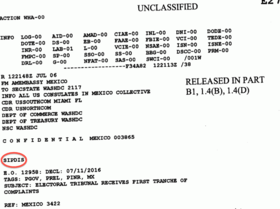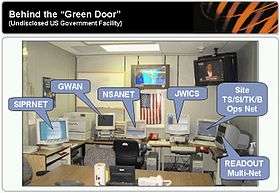SIPRNet
The Secret Internet Protocol Router Network (SIPRNet) is "a system of interconnected computer networks used by the U.S. Department of Defense and the U.S. Department of State to transmit classified information (up to and including information classified SECRET) by packet switching over the 'completely secure' environment". It also provides services such as hypertext document access and electronic mail. As such, SIPRNet is the DoD's classified version of the civilian Internet.

SIPRNet is the SECRET component of the Defense Information Systems Network.[1] Other components handle communications with other security needs, such as the NIPRNet, which is used for nonsecure communications, and the Joint Worldwide Intelligence Communications System (JWICS), which is used for Top Secret communications.
Access

According to the U.S. Department of State Web Development Handbook, domain structure and naming conventions are the same as for the open internet, except for the addition of a second-level domain, like, e.g., "sgov" between state and gov: openforum.state.sgov.gov.[2] Files originating from SIPRNet are marked by a header tag "SIPDIS" (SIPrnet DIStribution).[3] A corresponding second-level domain smil.mil exists for DoD users.[4]
Access is also available to a "...small pool of trusted allies, including Australia, Canada, the United Kingdom and New Zealand...".[5] This group (including the US) is known as the Five Eyes.
SIPRNet was one of the networks accessed by Chelsea Manning, convicted of leaking the video used in WikiLeaks' "Collateral Murder" release[6] as well as the source of the US diplomatic cables published by WikiLeaks in November 2010.[7]
Alternate names
SIPRNet and NIPRNet are referred to colloquially as sipper-net and nipper-net (or simply sipper and nipper), respectively.
See also
- CAVNET
- Classified website
- NIPRNet
- RIPR
- Intellipedia
- Protective distribution system
- NATO CRONOS
References
- "Secret Internet Protocol Router Network (SIPRNET)". Federation of American Scientists' Intelligence Resource Program. Retrieved 12 December 2010.
- "U.S. Department of State Foreign Affairs Handbook Volume 5 Handbook 8 - Web Development Handbook: 5 FAH-8 H-342.2 ClassNet Standards". U.S. Department of State. 29 September 2005. Retrieved 12 Jan 2016.
- "Siprnet: Where the leaked cables came from". BBC. 29 November 2010. Retrieved 19 December 2010.
- Grimes, John G. (14 April 2008). "Internet Domain Name Use and Approval" (PDF). Department of Defense.
- Field, Michael (2 December 2010). "NZ way down the WikiLeaks queue". Fairfax New Zealand. Retrieved 17 December 2010.
- Poulsen, Kevin; Zetter, Kim (6 June 2010). "U.S. Intelligence Analyst Arrested in Wikileaks Video Probe". Wired. Retrieved 15 June 2010.
- Leigh, David (28 November 2010). "US embassy cables leak sparks global diplomacy crisis". The Guardian. Retrieved 28 November 2010.
External links
- DISA
- Secret Internet Protocol Router Network (SIPRNET) by the Federation of American Scientists' Intelligence Resource Program
- They've Got Learning Locked Down – article detailing U.S. Coast Guard Academy classroom being first to get access to SIPRNet
- BBC Article on SIPRNet